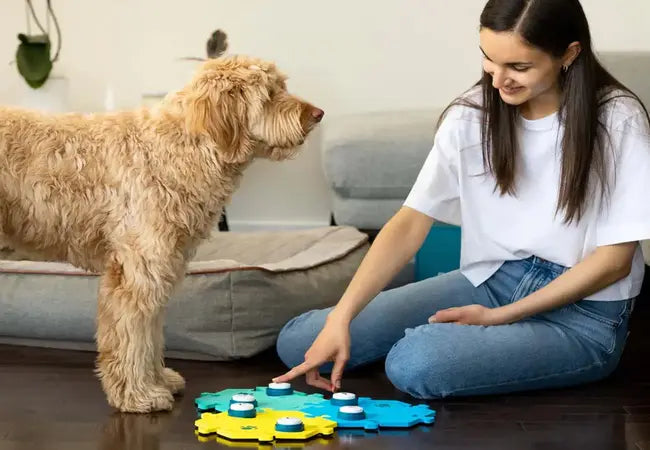How Do Talking Dog Buttons Work in 2025 – Vet‑Approved Guide to Canine Soundboard Communication 🐶🔘

In this article
How Do Talking Dog Buttons Work in 2025 – Vet‑Approved Guide to Canine Soundboard Communication 🐶🔘
By Dr. Duncan Houston BVSc
Have you seen dogs like Bunny using colored buttons to ask for “play,” “outside,” or “food,” and wondered if it’s real? In this 2025 vet‑approved guide, I'll explain how talking dog buttons work, what science says about them, what they can and can’t do, and how you can safely try communication with your dog. Let's dive into this fascinating frontier of interspecies interaction! 🧠🐾
1. 🔘 What Are Talking Dog Buttons?
Talking buttons are recordable soundboards that play a pre-recorded word or phrase when your dog presses them with a paw or nose.
- Each button is programmed with a single word—like “Walk,” “Food,” or “Water.”
- Buttons are often arranged on mats in consistent locations to help dogs find them easily.
2. 🧠 How Dogs Learn Button Communication
Dogs learn to press buttons through association and reinforcement, similar to basic training:
- Owners model by pressing a button, then rewarding their dog, e.g., pressing “Walk,” then opening the door.
- After repetition, the dog learns: pressing “Walk” → door opens, and they go outside.
While this reflects conditional learning, some dogs progress to combining buttons to express more nuanced requests (e.g. “Outside + Potty”).
3. 🧩 Evidence & Skepticism: What Science Shows
Research supporting understanding:
A recent UC San Diego study showed dogs across homes could press buttons intentionally and combine words more often than chance.
Dogs responded appropriately to words even when pressed by someone other than their owner, suggesting real word recognition.
Where BIG questions remain:
- Experts caution it's unclear if dogs truly grasp concepts or only anticipate outcomes based on routine.
- This behavior could be driven by cueing or owner influence—or be a form of operant conditioning, not true language.
- Some dogs show remarkable creativity—stitching together novel phrases (“squeaker + car” for ambulance)—but these are isolated cases and under study.
4. 🐶 Famous Case Study: Bunny the Sheepadoodle
Bunny became a social media star by learning ~92 word buttons and forming 3–4 word combos.
She’s a participant in a UCSD research study and uses tokens like “outside,” “potty,” “love you,” and even “ouch” to express herself.
5. ✅ Benefits of Button Communication
- ✨ Enhanced clarity: Dogs can specify needs (e.g., “outside” vs “potty”), reducing frustration.
- 🤝 Bond strength: Encourages more intentional engagement and mutual learning.
- 🧩 Mental enrichment: It’s a brain-stimulating task promoting cognitive engagement.
- 📣 Data-driven insight: Apps like FluentPet track button use patterns to identify meaningful trends.
6. ⚠️ Limitations & Pitfalls to Know
- Not all dogs may learn button use effectively—success varies with temperament, training, and guidance.
- Potential over-interpretation by owners—assuming deeper meanings from random combinations.
- It may reflect Pavlovian associative learning, not true language comprehension.
- Interpretive bias: When dogs press buttons in casual context, humans may instinctively impose meaning.
7. 🛠️ How to Try Talking Buttons Safely
Step-by-step setup:
- Choose clear words relevant to your dog’s daily needs—like “Food,” “Outside,” “Play.”
- Record your voice on each button; place them consistently on a mat.
- Model use: press button, respond immediately (e.g., “Outside” → open door).
- Reinforce: reward your dog when they press it.
- Add words slowly—1 at a time to avoid confusion.
- Track patterns—if using FluentPet or another app, note consistent uses.
Tips to avoid biases:
- Use never-before-used words unpredictably (like hiding a “Potty” button) to test animal-initiated pressing.
- Avoid cues—button placement and timing should not signal to the dog.
- Maintain consistency and patience—training may take weeks or months.
8. 🧩 Veterinary & Behavioral Considerations
Health benefits:
- Promotes mental stimulation—key for aging dogs or those with anxiety.
- Helps dogs express needs, reducing frustration barking or door scratching.
Questions to review:
- Is my dog physically able to press buttons easily?
- Is this enriching or becoming repetitive/stressful?
- Am I interpreting random button presses as meaningful?
When to consult a vet or behaviorist:
- If button use triggers compulsive behavior.
- If it's used to express distress—like frequent “help” or “scared” presses.
- When cognitive training is needed (e.g., for aging pets).
9. 📱 Ask A Vet App 2025 Integration
Use the Ask A Vet app to:
- 📹 Upload videos of button use for vet or behavioral review.
- 🧠 Get personalized advice: vocabulary design, reinforcement plans, usage interpretation.
- 💬 Chat live with professionals to optimize training and prevent miscommunication.
🔟 Final Thoughts
Talking dog buttons open a window into enriched communication—but they’re not magic. They’re tools that allow dogs to associate sounds with actions, and some dogs even combine words, suggesting early expressive capacity. While many questions remain about depth of understanding, we know this method encourages mental exercise, strengthens bonds, and can reduce frustration. In 2025, with informed use, button boards can be a welcome, enriching channel—not a substitute—for human-dog interaction. 🐶💬
Curious about trying buttons with your dog? Visit AskAVet.com or download the Ask A Vet app to share your button board videos and receive expert guidance tailored to your dog’s communication journey.






